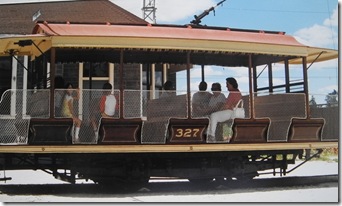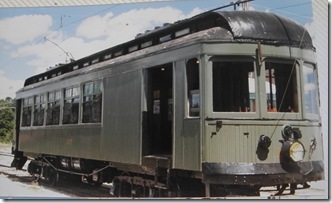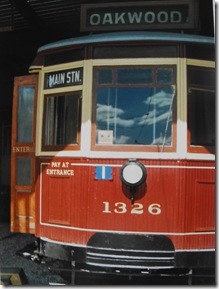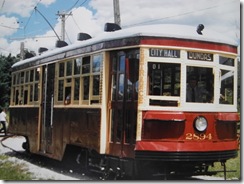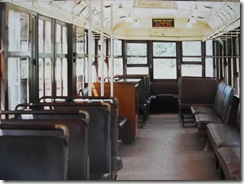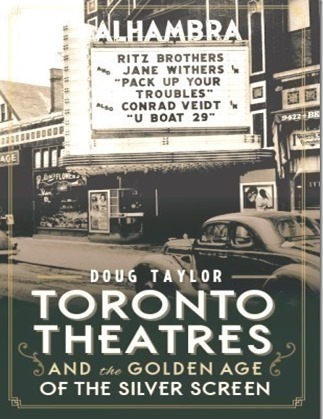As a child, a streetcar ride was an adventure. On our street, only one family owned an automobile, and thus we walked to most places. For destinations more distant, we rode a streetcar. If the streetcar were crowded, my brother and I competed for any remaining window seat. Even today, I enjoy riding the “red rockets” of Toronto. I much prefer them to the subways.
In the first decade of the twentieth century, when the open-sided streetcars appeared on routes such as Queen Street, residents of “Toronto the Good” knew that summer had truly unfolded. Avenues were relatively uncongested with vehicle traffic in those days, and it was considered save to hop on and off a streetcar with the sides open to the passing scene and the refreshing breezes of a hot summer’s day.
Since only the wealthy owned automobiles, the streetcar was the only means of travel for distances that were too far to walk. However, sometimes families rode the open-sided streetcars simply as an excursion. A trip on the Queen Streetcar to the distant beaches at Woodbine or Kew Beaches were as exciting for children as a modern-day trip to Disneyland.
During the 1940s, I remember riding a streetcar such as the one in the picture on the left. It was on Weston Road line, which extended from the Junction area of the city (Dundas and Keele Streets) to Lawrence Avenue West and Weston Road in the town of Weston. As a child, I was excited at the chance to ride the streetcar, particularly as my father had told me that it was an unusual streetcar – it did not turn around when it reached the end of the line.
I told my dad, “I don’t understand. If the streetcar can’t turn around, how do we get back to the city?”
My dad said, “The car is double-ended—there’s a set of controls at either end of the streetcar. To make the return trip, the motorman steps outside the streetcar and pulls down the pole attached to the overhead wire. Did you see the pole when we got on the streetcar? There’s a pole at the other end too.”
“Of course I saw them,” I replied defensively, feeling that my dad was talking-down to me.
“Well,” my dad continued, “he places one pole flat against the roof of the trolley. He then raises the pole at the opposite end of the car and attaches it to the overhead wire. Then he climbs up into the streetcar again. He removes the long handle that operates the controls inside the streetcar, and takes it to the other end of the streetcar, where there is another set of controls. Now he is ready to go in the opposite direction, along the single track that extends the length of the line.” I was amazed.
During the late 1940s, we lived near Rogers Road and Oakwood Avenue. Each Sunday we rode the Oakwood streetcar to attend church in the Rowntree District, near Rogers Road and Keele Street. To this day, I remember the wooden benches, the small coal stove for the winter months, and the large windows to observe the passing scene.
Of all the streetcars that I remember from my youth, none compares with the famous Peter Witt streetcars of the Yonge Street line. They first arrived in the city in 1921, and remained in service until the subway opened in 1953. The square-shaped streetcars trundled noisily along the roadway on ribbons of steel. Despite the hustle and bustle of the night-time bars and clubs, I remember when Yonge Street was quieter, calmer, and less hurried than today.
I was a teenager when they opened the subway. Today, I lament the demise of the old Peter Witt streetcars—“the grand old ladies of the street.” I grow nostalgic as I recall the years I huddled around the cars’ coal stoves on a winter morning, as the streetcars rumbled up the steep hill north of Bloor Street.
I recall that as a child, when crossing the intersection at Queen and Yonge, I viewed the busy street, peering north and south, with the bulky streetcars crowding the roadway amid the noisy vehicle traffic. As a youngster I journeyed downtown and glimpsed the marquee lights of Loew’s Downtown, the Imperial, and the Downtown Theatres from the streetcar windows. Even the smaller theatres, such as the Coronet, Biltmore, and Savoy garnered attention with their colourful signs advertising films about adventurers, pirates, gangsters, and gallant soldiers.
South of Bloor Street on a wintry evening, I gazed in fascination at Loew’s Uptown Theatre, its flashing marquee lights reflecting on the glass of the streetcar windows. The Yonge streetcars connected me to a world of lights, laughter, and entertainment.
My dad had told me that where the streetcar line terminated at Union Station, thousands of immigrants had arrived during the previous decades and passed through its grand hall. The Yonge streetcars had provided their first impression of the vibrant, new-world city that was to be their home.
The streetcars had carried men to war when they had departed from Union Station for the battlefields of Europe. At the end of the conflict, when Toronto celebrated, the Yonge streetcars provided the backdrop for the spontaneous parties that erupted on Yonge Street.
No other streetcars ever embedded themselves into the soul of Toronto like the Yonge streetcars. They were the streetcars that delivered children to places of adventure—Eaton’s Toyland, the Yonge Arcade, movie theatres, and toyshops.
To view the Home Page for this blog: https://tayloronhistory.com/
To view previous posts about movie houses of Toronto—old and new
https://tayloronhistory.com/2013/10/09/links-to-toronto-old-movie-housestayloronhistory-com/
To view links to other posts placed on this blog about the history of Toronto and its heritage buildings:
https://tayloronhistory.com/2013/10/08/links-to-historic-architecture-of-torontotayloronhistory-com/
Recent publication entitled “Toronto’s Theatres and the Golden Age of the Silver Screen,” by the author of this blog. The publication explores 50 of Toronto’s old theatres and contains over 80 archival photographs of the facades, marquees and interiors of the theatres. It also relates anecdotes and stories from those who experienced these grand old movie houses.
To place an order for this book:
Theatres Included in the Book
Chapter One – The Early Years—Nickelodeons and the First Theatres in Toronto
Theatorium (Red Mill) Theatre—Toronto’s First Movie Experience and First Permanent Movie Theatre, Auditorium (Avenue, PIckford), Colonial Theatre (the Bay), thePhotodome, Revue Theatre, Picture Palace (Royal George), Big Nickel (National, Rio), Madison Theatre (Midtown, Capri, Eden, Bloor Cinema, Bloor Street Hot Docs), Theatre Without a Name (Pastime, Prince Edward, Fox)
Chapter Two – The Great Movie Palaces – The End of the Nickelodeons
Loew’s Yonge Street (Elgin/Winter Garden), Shea’s Hippodrome, The Allen (Tivoli), Pantages (Imperial, Imperial Six, Ed Mirvish), Loew’s Uptown
Chapter Three – Smaller Theatres in the pre-1920s and 1920s
Oakwood, Broadway, Carlton on Parliament Street, Victory on Yonge Street (Embassy, Astor, Showcase, Federal, New Yorker, Panasonic), Allan’s Danforth (Century, Titania, Music Hall), Parkdale, Alhambra (Baronet, Eve), St. Clair, Standard (Strand, Victory, Golden Harvest), Palace, Bedford (Park), Hudson (Mount Pleasant), Belsize (Crest, Regent), Runnymede
Chapter Four – Theatres During the 1930s, the Great Depression
Grant ,Hollywood, Oriole (Cinema, International Cinema), Eglinton, Casino, Radio City, Paramount, Scarboro, Paradise (Eve’s Paradise), State (Bloordale), Colony, Bellevue (Lux, Elektra, Lido), Kingsway, Pylon (Royal, Golden Princess), Metro
Chapter Five – Theatres in the 1940s – The Second World War and the Post-War Years
University, Odeon Fairlawn, Vaughan, Odeon Danforth, Glendale, Odeon Hyland, Nortown, Willow, Downtown, Odeon Carlton, Donlands, Biltmore, Odeon Humber, Town Cinema
Chapter Six – The 1950s Theatres
Savoy (Coronet), Westwood
Chapter Seven – Cineplex and Multi-screen Complexes
Cineplex Eaton Centre, Cineplex Odeon Varsity, Scotiabank Cineplex, Dundas Square Cineplex, The Bell Lightbox (TIFF)
